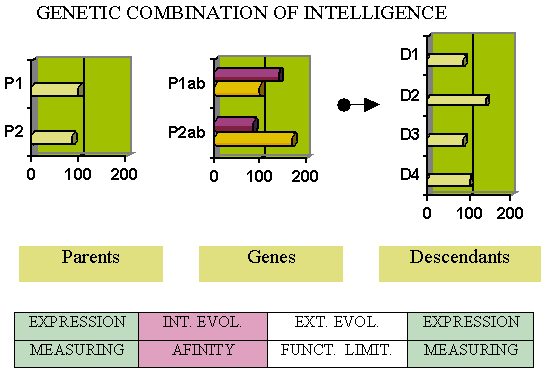6. STATISTICAL SIMULATION: GLOBAL MODEL
6.a) Computer simulation of the evolution of intelligence
- Actual values and observed values!
The Social Model –the properly reformulated Individual Model– has been useful to determine that the significant chromosome is the one with the least potential, there is only one relevant chromosome and it seems is the sexual one.
Due to the accuracy of the Social Model of the evolution of intelligence, and having all the elements to simulate the proposed model by the Conditional Evolution of Live (CEL), the researchers developed a computer simulation to confirm the results. The statistical simulation should generate artificial intelligence quotients –variable W– behaving like those observed in the longitudinal study.
A second big surprise was the initial failure of the simplified Social Model to obtain the objective of statistical simulation of the processes and mechanisms of biological inheritance of intelligence.
The task was much more complicated than previously thought, forcing to eliminate all the simplifications of the Social model.
The introduction of the ability to generate quantitative variables with disturbances close to real ones implies a new statistical simulation, the Global Model.

A typical result of the generated variable W is in the q050 graph. Considering that W is a stochastic variable, the figure represents the average of ten estimates for the corresponding correlations.
The Multidimensional Correlation Index (MCI) of the artificial intelligence quotients vector W, which is three times higher for comparative reasons, is over 25 and far above the Global Multidimensional Correlation Index (GMCI) for the observed C variables of the children.
Therefore, the Global Model needs to include the random deviations in the expression and measurement of intelligence and other variables of its evolution, which the Individual and Social Models had excluded for simplicity.
The Individual Model showed that the differences in IQ measurements of the same children were very high due to the manifestation of the child's capacity at any given moment, and even more so, over the years.
Other factors causing similar deviations are the intelligence test used and the specific test session within a standard test.
Although the observed differences are superior to 10% to the average in some cases, the Global Model introduces an additional combinatorial algorithm to represent a factor of a mean deviation of 3% upward and 3% downward.
For the same reason, the Global Model incorporates stochastic error patterns in children variables C and parents M and F.
Nevertheless, the high correlation of W in the computer simulation does not decrease substantially, and vector W does not behave like the original IQ vectors from the Stanford Binet and Wechsler intelligence tests.
6.b) Statistical simulation model: complexity and optimization
To capture the complexity of the Global Model, it is necessary to introduce elements that are more haphazard; otherwise, the model would not be acceptable. In particular, the new features must lower the correlation in the unordered groups, and mainly in the small groupings.
At the same time, in the previously rearranged groups, the correlations should decrease in the small groups and increase or remain the same in the big ones. Once achieved a good model specification for the evolution of intelligence, it could begin its optimization.
6.b.1) Genetic affinity
The first idea should be to eliminate the simplifications carried out in the model's theoretical argumentation to avoid its complexity.
To continue dropping the multidimensional correlation index of W, the Global Model will include the filter effect mentioned by the Conditional Evolution of Life (CEL) in the proposal for a statistical simulation model regarding the resulting intellectual power of the genetic combination. Now, it will be equal to the intersection of the potentials and not to the smaller one.
Of course, this decrease due to the lack of genetic affinity will not be equal in all cases. Consequently, it will imply a random pattern in the statistical simulation; meaning another margin of 3% upwards or downwards bearing in mind the possible drag effect of the ancestors.
After considering this affinity filter effect, the correlation lowers again, but not much. The complexity of the statistical simulation model continues to increase while adding elements.
